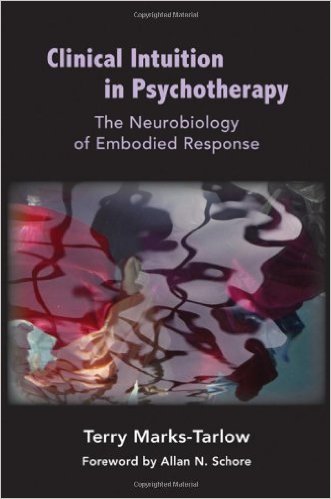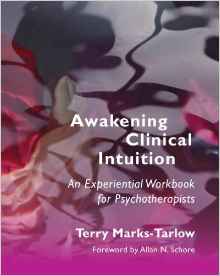
Can You Get Intuit?
Two New Books on Intuition

Clinical Intuition in Psychotherapy:
The
Neurobiology of Embodied Response
And

An
Experiential Workbook for Psychotherapists
By
Terry Marks-Tarlow, Ph.D.
Intuition
has been around, as a word, since the middle ages. It’s original meaning meant
direct spiritual perception, a view that deserves a modern counterpart. Carl
Jung did a lot to legitimatize intuition, giving it a role and relationship to
other mental processes. Today there are countless books on the subject of the
reality and value of intuition and learning to use it in one’s life.
=====
To explore
Clinical Intuition in Psychotherapy: The Neurobiology of Embodied Response
on Amazon.com,
click here!
To explore
Awakening Clinical Intuition: An Experiential Workbook for Psychotherapists
on Amazon.com,
click here!
I don't even
believe in the word "normal", especially from the point of view of nonlinear
science. Perhaps ordinary versus extraordinary knowing is better language, as in
the work of Elizabeth Mayer.
Despite my backing away from parapsychology as a research career, I have veered
back in that direction anyway, both personally and professionally.
Q1: Who's the reader you had in mind when you wrote your booki?Describe the
therapist you envisioned who would read your book.
When I wrote this book, I had a grand vision of any and every psychotherapist
reading and benefitting from the combination parent text and workbook. Because I
truly believe clinical intuition is at the heart of healing and successful
psychotherapy, I also believe the topic needs to be front and center, both from
the start of clinical training and all the way through every clinician's career,
independent of orientation or modality.
Q2: What's a therapist to gain from reading your book?
My hope for therapists reading my books is gaining greater interest in their own
internal processes and unique style of interacting with themselves and with
patients/clients. This contrasts to addictive interest in how-to approaches
and outer modes, methods, and models of treatment. I'm not saying that
treatment models and technique manuals can't be useful, but more that they need
to be integrated with inner sensibilities as the foundation. I would also hope
therapists could gain greater trust in their own inner voices and inside
truths, even in the face of great uncertainty, which is what clinical work is
all about.
Q3: What insight from your book do you find yourself smiling about the most?
That's most important?
I love this question! The insight from my books that most makes me smile is
this: there is nothing magical about clinical intuition at the very same time is
that everything is magical about clinical intuition. There is nothing magical
about intuition because we can now use the framework of interpersonal
neurobiology to understand what's going on and how it works (to some degree).
Everything is magical about clinical intuition, because all of the intellectual
understanding in the world doesn't change the experience of intuition in action.
And when deep truths emerge from the bottom-up out of the relational unconscious
and we learn how to honor them, processes and results often feel inexplicably
miraculous.
Q4: Do you feel that therapists need an excuse, or rationale, to trust their
intuition during therapy? Does your book provide something of that sort?
Unfortunately, I feel that a lot of clinicians are either afraid or ashamed to
trust their intuition, because there is such an emphasis on manualized
approaches, empirically validated methods, and well-laid out treatment models,
as if one model could fit all. In so far as my approach is very well grounded in
neuroscience and ethology, it certainly helps to support the importance and
validity of trusting our intuition. In the examples I cite, I tried to supply
unusual and unique clinical cases in order to demonstrate where only an
intuitive approach could have worked. Anything else would have missed the
nuances and complexities involved.
Q5: Isn't empathy with a client an act of intuitive imagination? How might
intuition go beyond that?
Yes, yes yes! Empathy with a client involves an act of imagination. Too few
therapists understand this critical role of imagination during therapy. It takes
imagination to see the world through the eyes of another. That's one piece of
it. But, as you suggest, intuition goes beyond this, because it also takes
imagination to foresee beyond where a client lives emotionally in the moment.
This allows us to hold and "see" a person's future potential, even if he or she
is feeling hopelessly depressed. If we can't do that, then we run the risk of
simply wallowing in current traumas and struggles. This form of
intuition--imagining future potential and how to guide towards it--is a fuzzy
sort of imagination, more like being a parent and holding out hope and promise
for growth to come, without expectations, demands, or needs for that growth to
take particular form. Here is where intuition so clearly dovetails with acts of
creativity.
Q6: Equine assisted therapists claim that horses respond intuitively to the
client by acting out the client's unacknowledged feelings. Some of your
description and discussion of therapist intuition resembles the horse's
response. Do you find a connection there?
Perhaps your observation about equine therapy gives us a clue why intuition is
sometimes called "horse sense." Indeed, the process you describe--of horses
acting out a client's unacknowledged emotion is familiar to all sensitive
therapists. This is technically called "projective identification" and happens
because of open boundaries between self and other at all levels. In projective
identification, unconscious or dissociated emotion is picked up by another
person's body, which serves as a kind of resonant chamber, just like the horse
is doing. Mammals like horses are particularly receptive to this kind of
nonverbal, emotional communication, because they don't have thinking cortexes to
block or distract from reception of raw and primitive, body-based emotion.
Q7: (What question would you wish I would ask?)
The question I would like you to ask me is this: "What is the most important
thing you've learned out of your journey into clinical intuition?" My answer is
that the mind/body/brain of self/other is a single system. Anything less is a
fragmented view and an illusion, akin to the veil of Maya. The more I embrace
the wholeness of this perspective, the better able I am to embody my own truths,
and the more powerful the work feels. Thanks for asking!
![]()
Q8: Given that your book is so original, and unique, I am wondering what other
references on intuition did you consult?
Thanks you
so much for your kind words! Writing original books is very important to me. And
for exactly that reason, in order to write these books, I strove to reach down
into my own unconscious as well as to use my own implicit and explicit
experience as a guide. If I get too close to other people's clinical work, I all
too easily fall down the rabbit hole of adoration. This can cause me to lose my
own perspective and solid core.
Q9: What theorist of intuition is your work most closely aligned to?
Quite
frankly, in researching this book, I found very little in my own field that was
helpful. There was a gaping hole in theory and science underlying clinical
intuition. Early on, I decided to fill this hole by studying the underlying
neuroscience and then using my own intuition to guide me. That said, if I had
to pick a single person most influential to my perspective, I'd choose Jaak
Panksepp, father of affective neuroscience. To study the neurobiology of the
SEEKING, CARE, and PLAY motivational/emotional circuitry in all mammals was to
shine a light on the underlying nonconscious skill set of clinicians. In
addition, there is one clinical psychologist whose work I found truly
inspirational--Elizabeth Lloyd Mayer. Her book,
Extraordinary Knowing, marked the outer, paranormal edges of
clinical intuition. While I have personally and professionally visited these
edges often, in counterpoint, my own work emphasizes the more ordinary magic of
clinical intuition as it informs embodied perception and response on a
moment-to-moment basis.
Q10: There have been many books coming out on intuition... what sets yours apart
from the rest? What are some of the common
statements/assumptions about intuition in other folks's books on intuition that
you take exception to?
I am very
sorry , but I am completely ignorant about these kinds of books that
are targeted for the general public in order to address intuition in everyday
life. I really did need to separate myself from this literature almost
completely in order to locate my own voice. So, dear Henry, I leave it to you to
answer the question of what sets my work apart from these other folks, yourself
included. Perhaps, you can even intuit what I might take exception to, based on
your reading of my work.
Q11: There have been other therapists who have written about intution, but you
seem to be directing your work to therapists specifically, especially those who
work in an atmosphere where you have to document and defend each therapeutic
maneuver, to give them something "scientific" to base intuitive responses on. Is
that a fair assessment?
Yes, this is
a fair assessment . As the social climate of psychotherapy moves more towards
preconceived, manualized modes of treatment in combination with defense-based
documentation , I wish to boost the morale of those true healers who buck this
trend. I want to provide the scientific rationale for conceptualizing each
person and clinical encounter as unique, which forces us to rely on our own gut
responses in the heat and heart of the clinical moment. As I assert many times,
with attunement via interpersonal neurobiology as a framework, I firmly believe
it's unethical not to place clinical intuition at the heart of clinical training
and center of effective psychotherapy.
=========
To explore
Clinical Intuition in Psychotherapy: The Neurobiology of Embodied Response
on Amazon.com,
click here!
To explore
Awakening Clinical Intuition: An Experiential Workbook for Psychotherapists
on Amazon.com,
click here!
Review by Henry Reed